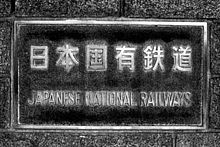Japanese National Railways
(日本国有鉄道 Nihon Kokuyū Tetsudō), abbreviated Kokutetsu (国鉄) or "JNR", was the body which operated the national railway network of Japan from 1949 to 1987.(all this info was gathered from Wikipedia)
Railways
As of June 1, 1949, the date of establishment of JNR, it operated 19,756.8 km (12,276.3 mi) of narrow gauge (1,067 mm/3 ft 6 in) railways in all 46 prefectures of Japan (Okinawa, the 47th prefecture, returned to the Japanese administration in 1972 but no JNR line existed in Okinawa). This figure expanded to 21,421.1 km (13,310.5 mi) in 1981 (excluding Shinkansen), but later reduced to 19,633.6 km (12,199.8 mi) as of March 31, 1987, the last day of JNR.JNR operated both passenger and freight services.
Shinkansen, the world-first high-speed railway was debuted by JNR in 1964. By the end of JNR in 1987, four lines were constructed:
- Tōkaidō Shinkansen
- 515.4 km (320.3 mi), completed in 1964
- Sanyō Shinkansen
- 553.7 km (344.1 mi), completed in 1975
- Tōhoku Shinkansen
- 492.9 km (306.3 mi), as of 1987
- Jōetsu Shinkansen
- 269.5 km (167.5 mi), completed in 1982
Unions
A number of unions represented workers at JNR, including the National Railway Workers' Union (Kokuro), the National Railway Locomotive Engineers' Union (Doro), and Doro-Chiba, a break-away group from doro.History
In 1949, JGR was reorganized into JNR, a state-owned public corporation by a directive of the U.S. General HQ in Tokyo. JNR enjoyed many successes, including the 1964 inauguration of high-speed Shinkansen service. However, JNR was not a state-run corporation; its accounting was independent from the national budget. Rural sections without enough passengers began to press its management, pulling it further and further into debt.[citation needed]
By 1987, JNR's debt was over ¥27 trillion ($280 billion at 2009 exchange rates) and the company was spending ¥147 for every ¥100 earned. By an act of the Diet of Japan, on April 1, 1987 JNR was privatized and divided into seven (= six passenger and one freight) railroad companies. They have been collectively called the Japan Railways Group (JR Group). Long-term liabilities of JNR were taken over by the JNR Settlement Corporation (disbanded in 1998), and the corporation's remaining debts were transferred to the national budget's general accounting.
Timeline
- June 12, 1872: Provisional opening of Tokyo–Yokohama railway (Shinagawa Station–Yokohama Station)
- October 1, 1907: Completion of nationalization of 17 private railways under 1906 Railway Nationalization Act
- June 1, 1949: Japanese National Railways organized
- October 1, 1964: Inauguration of the Tōkaidō Shinkansen high-speed line
- April 1, 1987: Privatization of JNR, establishment of seven JR companies
- October 22, 1998: JNR Settlement Corporation was officially dissolved. All its debts were transferred to the national budget's general accounting. By this time the debt has risen to ¥30 trillion ($310 billion in 2009 dollars). The debt was later incorporated into the national government's general debt.
Accidents and criminal incidents
Accidents
JNR as a public corporation (from 1949 to 1987) experienced five major accidents (including two shipwrecks of railway ferries) with casualties more than 100:- Sakuragichō train fire
- A train fire at Sakuragichō Station in Yokohama on April 24, 1951 killed 106.
- Toya Maru disaster
- A Seikan ferryboat sank off Hakodate killing 1,155 in a typhoon storm on September 26, 1954.
- Shiun Maru disaster
- An Ukō ferryboat collided with a fellow boat in a dense fog and sank killing 166 on May 11, 1955.
- Mikawashima rail crash
- A three-train collision near Mikawashima Station in Tokyo on May 3, 1962 killed 160.
- Yokohama rail crash
- A three-train collision near Tsurumi Station in Yokohama on November 9, 1963 killed 161.
Criminal incidents
In its very early days as a public corporation, JNR experienced a series of mysterious incidents as follows. Although the police at that time treated them as terrorism by the communists, doubts have been raised as to the validity of this conclusion.- Shimoyama incident
- The dismembered body of JNR President Sadanori Shimoyama was found on a railway track on July 5, 1949. (The possibility of non-criminal suicide has not been ruled out.)
- Mitaka incident
- A train running without crew crashed into passengers and killed six people on July 15, 1949.
- Matsukawa incident
- A train was derailed because of destroyed track and three crew were killed on August 17, 1949.
As such, the relationship with labor unions was always a difficult problem for JNR. Since public workers were prohibited to strike, they carried out "work-to-rule protests" that caused trains to be delayed. On March 13, 1973, train delays caused by such protests resulted in a riot of angered passengers at Ageo Station in Saitama Prefecture (Ageo incident). From November 26, 1975 to December 3, 1975, major labor unions of JNR conducted an eight-day-long illegal "strike for the right to strike", which resulted in a total defeat of the unions.
Privatization
When privatization of JNR was proposed in the mid 1980s, JNR unions were strongly opposed and campaigned against it. The campaign was unsuccessful and JNR was privatized in 1987, and replaced by the Japan Railways Group (JR Group).Lists of workers to be employed by the new organizations were drawn up by JNR and given to the JR companies. There was substantial pressure on union members to leave their unions, and within a year, the membership of the National Railway Workers' Union (Kokuro) fell from 200,000 to 44,000. Workers who had supported the privatization, or those who left Kokuro, were hired at substantially higher rates than Kokuro members.

No comments:
Post a Comment